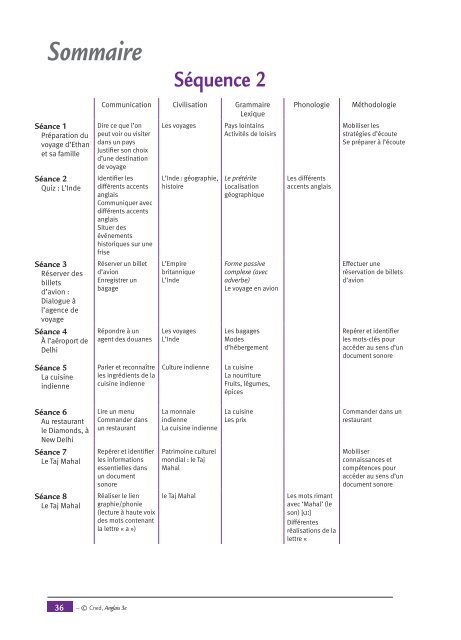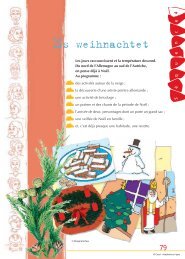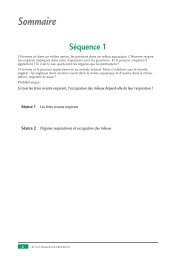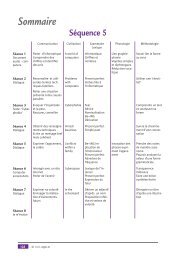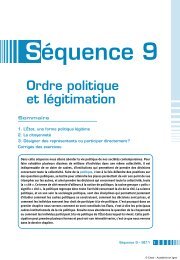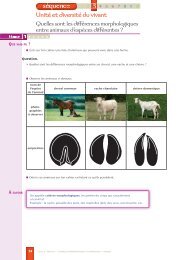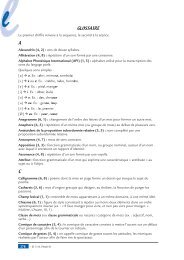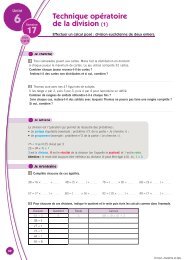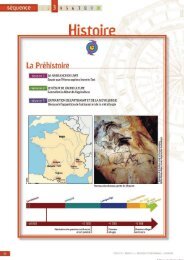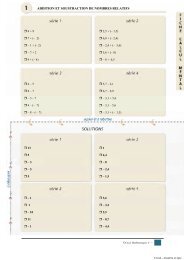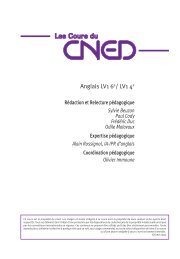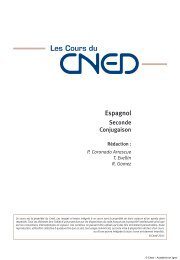Travelling to India
Travelling to India
Travelling to India
Create successful ePaper yourself
Turn your PDF publications into a flip-book with our unique Google optimized e-Paper software.
Sommaire<br />
Séquence 2<br />
Communication Civilisation Grammaire<br />
Lexique<br />
Phonologie<br />
Méthodologie<br />
Séance 1<br />
Préparation du<br />
voyage d’Ethan<br />
et sa famille<br />
Dire ce que l’on<br />
peut voir ou visiter<br />
dans un pays<br />
Justifier son choix<br />
d’une destination<br />
de voyage<br />
Les voyages<br />
Pays lointains<br />
Activités de loisirs<br />
Mobiliser les<br />
stratégies d’écoute<br />
Se préparer à l’écoute<br />
Séance 2<br />
Quiz : L’Inde<br />
Identifier les<br />
différents accents<br />
anglais<br />
Communiquer avec<br />
différents accents<br />
anglais<br />
Situer des<br />
événements<br />
his<strong>to</strong>riques sur une<br />
frise<br />
L’Inde : géographie,<br />
his<strong>to</strong>ire<br />
Le prétérite<br />
Localisation<br />
géographique<br />
Les différents<br />
accents anglais<br />
Séance 3<br />
Réserver des<br />
billets<br />
d’avion :<br />
Dialogue à<br />
l’agence de<br />
voyage<br />
Réserver un billet<br />
d’avion<br />
Enregistrer un<br />
bagage<br />
L’Empire<br />
britannique<br />
L’Inde<br />
Forme passive<br />
complexe (avec<br />
adverbe)<br />
Le voyage en avion<br />
Effectuer une<br />
réservation de billets<br />
d’avion<br />
Séance 4<br />
À l’aéroport de<br />
Delhi<br />
Répondre à un<br />
agent des douanes<br />
Les voyages<br />
L’Inde<br />
Les bagages<br />
Modes<br />
d’hébergement<br />
Repérer et identifier<br />
les mots-clés pour<br />
accéder au sens d’un<br />
document sonore<br />
Séance 5<br />
La cuisine<br />
indienne<br />
Parler et reconnaître<br />
les ingrédients de la<br />
cuisine indienne<br />
Culture indienne<br />
La cuisine<br />
La nourriture<br />
Fruits, légumes,<br />
épices<br />
Séance 6<br />
Au restaurant<br />
le Diamonds, à<br />
New Delhi<br />
Lire un menu<br />
Commander dans<br />
un restaurant<br />
La monnaie<br />
indienne<br />
La cuisine indienne<br />
La cuisine<br />
Les prix<br />
Commander dans un<br />
restaurant<br />
Séance 7<br />
Le Taj Mahal<br />
Repérer et identifier<br />
les informations<br />
essentielles dans<br />
un document<br />
sonore<br />
Patrimoine culturel<br />
mondial : le Taj<br />
Mahal<br />
Mobiliser<br />
connaissances et<br />
compétences pour<br />
accéder au sens d’un<br />
document sonore<br />
Séance 8<br />
Le Taj Mahal<br />
Réaliser le lien<br />
graphie/phonie<br />
(lecture à haute voix<br />
des mots contenant<br />
la lettre « a »)<br />
le Taj Mahal<br />
Les mots rimant<br />
avec ‘Mahal’ (le<br />
son) [a:]<br />
Différentes<br />
réalisations de la<br />
lettre «<br />
36<br />
— © Cned, Anglais 3e
séance 1 —<br />
Séquence 2<br />
Séance 1<br />
J’applique les stratégies de compréhension<br />
d’un document sonore que j’ai apprises<br />
J’aborde la thématique des voyages<br />
Step 1<br />
Ethan’s next winter trip.<br />
Ethan is thrilled! Next winter he is going on a vacation with his family <strong>to</strong> a distant country!<br />
Ethan and his parents are going <strong>to</strong> have a conversation about their next vacation: everyone gets <strong>to</strong><br />
pick where they want <strong>to</strong> go.<br />
There are so many fabulous destinations: Hawaii, Cancun, Colorado, Japan, the West Indies,<br />
Australia…<br />
Which country do you think they will choose <strong>to</strong> visit after all?<br />
© Cned, Anglais 3e — 37
Séquence 2 — séance 1<br />
Méthodologie<br />
Tu as appris ou revu en Séquence 1 plusieurs stratégies d’écoute d’un document sonore.<br />
Rappelle-<strong>to</strong>i quelles méthodes tu peux utiliser pour aborder et comprendre un message<br />
sonore.<br />
Tu vas entendre une conversation entre plusieurs personnes.<br />
Résume l’une des stratégies abordées en séquence 1 :<br />
Que faire avant d’écouter un document dont on connaît à l’avance la thématique ?<br />
Ici : les voyages.<br />
Réponds : ..........................................................................................................................<br />
Ë Fais-le :<br />
..........................................................................................................................................<br />
..........................................................................................................................................<br />
..........................................................................................................................................<br />
..........................................................................................................................................<br />
Exercise 1<br />
Listen <strong>to</strong> the conversation between Ethan, Katie and their parents, Susan and John.<br />
Underline in the above box the words you actually heard.<br />
Exercise 2<br />
Listen again and tick the boxes corresponding <strong>to</strong> the places they mention:<br />
® Hawaï<br />
® Transylvania<br />
® the Carribeans<br />
® France<br />
® Cancun<br />
® Romania<br />
® Italy<br />
® <strong>India</strong><br />
® Britain<br />
Then underline their future destination.<br />
38<br />
— © Cned, Anglais 3e
séance 1 —<br />
Séquence 2<br />
Exercise 3<br />
Now listen <strong>to</strong> the conversation one more time and tick the boxes. (Several boxes can be<br />
ticked each time) or answer the questions with full sentences.<br />
1- What is wrong with the idea of visiting a theme park?<br />
® It is <strong>to</strong>o expensive. They don’t have the funds.<br />
® They have already been <strong>to</strong> a theme park in Europe<br />
® The kids are a bit <strong>to</strong>o old for that<br />
® Theme parks will be overcrowded (<strong>to</strong>o many people there)<br />
2- Why would Hawaï be a fine family destination, according <strong>to</strong> Susan?<br />
® She thinks Ethan and Katie could do lots of activities there<br />
® She said it would be great <strong>to</strong> lie down on the beach and do nothing<br />
® She’d like <strong>to</strong> spend some time with her husband<br />
® She said the kids would be so tired with all the beach activities that they would go <strong>to</strong><br />
bed early<br />
3- What is wrong with…<br />
a) a cruise?<br />
..........................................................................................................................................<br />
b) visiting a castle in Eastern Europe?<br />
..........................................................................................................................................<br />
4- What is there <strong>to</strong> see or <strong>to</strong> do in the last place they mention?<br />
® visit mosques and temples<br />
® buy colourful clothes<br />
® visit a company<br />
® drink a special kind of tea<br />
® visit zoos<br />
® see kangaroos<br />
® visit an architectural wonder of the world<br />
5- Write down an expression from the dialogue expressing advice.<br />
..........................................................................................................................................<br />
6- According <strong>to</strong> John, how many people speak English throughout the world?<br />
® less than 300 million<br />
® more than 350 million<br />
® more than 500 million<br />
® more than 700 million<br />
7- What is the official language in <strong>India</strong>?<br />
® Urdu<br />
® Hindi<br />
® English<br />
® Bengali<br />
® Punjabi<br />
Check and correct<br />
© Cned, Anglais 3e — 39
Séquence 2 — séance 2<br />
Séance 2<br />
Je découvre l'Inde : sa géographie, son his<strong>to</strong>ire, sa culture<br />
Step 2<br />
Test your knowledge!<br />
Exercise 4<br />
Je revois les différents accents britanniques<br />
How much do you know about <strong>India</strong>?<br />
Match the beginning of the sentences in column 1 with the corresponding endings in<br />
column 2.<br />
<strong>India</strong> is located… 1 A …were at war in 1965.<br />
New Delhi is… 2 B … Pakistan, China, Nepal, Bhutan,<br />
Bangladesh and Myanmar.<br />
<strong>India</strong> is shaped like… 3 C …in South Asia.<br />
<strong>India</strong>, Pakistan and China do not 4 D ...the capital of <strong>India</strong>.<br />
agree on…<br />
<strong>India</strong> has common borders with… 5 E …the limits of Kashmir.<br />
<strong>India</strong> and Pakistan…. 6 F … a diamond<br />
Exercise 5<br />
Which of these flags is the <strong>India</strong>n flag?<br />
Exercise 6<br />
The <strong>India</strong>n accent.<br />
® ® ® ®<br />
Listen <strong>to</strong> English accents from around the world.<br />
You know that there is a wide variety of English accents throughout the world.<br />
Write down the English accents or varieties of English you can think of:<br />
1- …………………… English<br />
2- …………………… English<br />
3- …………………… English<br />
4- …………………… English<br />
5- …………………… English<br />
40<br />
— © Cned, Anglais 3e
séance 2 —<br />
Séquence 2<br />
6- …………………… English<br />
7- …………………… English<br />
8- …………………… English<br />
9- …………………… English<br />
Now listen <strong>to</strong> the same sentences being read by different native speakers from assorted<br />
English speaking countries.<br />
Tick the box corresponding <strong>to</strong> the country you assume the speaker comes from in each<br />
extract.<br />
Here is the passage that will be read:<br />
An immense mausoleum of white marble, built in Agra between 1631 and 1648<br />
by order of the Mughal emperor Shah Jahan in memory of his favourite wife, the<br />
Taj Mahal is the jewel of Muslim art in <strong>India</strong> and one of the universally admired<br />
masterpieces of the world’s heritage.<br />
Extract # 1<br />
® Australia ® the USA ® Scotland<br />
® England ® Ireland ® the Caribbeans ® <strong>India</strong><br />
Extract # 2<br />
® Australia ® the USA ® Scotland<br />
® England ® Ireland ® the Caribbeans ® <strong>India</strong><br />
Extract # 3<br />
® Australia ® the USA ® Scotland<br />
® England ® Ireland ® the Caribbeans ® <strong>India</strong><br />
Extract # 4<br />
® Australia ® the USA ® Scotland<br />
® England ® Ireland ® the Caribbeans ® <strong>India</strong><br />
Extract # 5<br />
® Australia ® the USA ® Scotland<br />
® England ® Ireland ® the Caribbeans ® <strong>India</strong><br />
Exercise 7<br />
YOUR TURN: Read the above text about the Taj Mahal with different English accents.<br />
Don’t forget the <strong>India</strong>n accent!<br />
Listen <strong>to</strong> your CD as many times as necessary.<br />
Exercise 8<br />
Did you know that <strong>India</strong>’s his<strong>to</strong>ry goes back almost six thousand years?<br />
“<strong>India</strong> is the cradle of human race, the birthplace of human speech, the mother of<br />
his<strong>to</strong>ry, the grandmother of legend, and the great grandmother of tradition.”<br />
Mark Twain (1835-1910)<br />
American author of Adventures of Huckleberry Finn and The Adventures of Tom Sawyer<br />
© Cned, Anglais 3e — 41
Séquence 2 — séance 2<br />
Vocabulary help: The cradle: le berceau<br />
Travel through the major events in <strong>India</strong>’s his<strong>to</strong>ry:<br />
First put the following dates in chronological order. Write them in the empty boxes on the<br />
timeline.<br />
1965 2000 1947 326 BC AD 50 1915<br />
2500 BC 1638 1948 1858 1600s<br />
1 2 3 4 5<br />
6 7 8 9 10<br />
Read the following events that belong <strong>to</strong> <strong>India</strong>’s His<strong>to</strong>ry and number them in chronological<br />
order.<br />
Events number 1 and number 10 have been written down for you!<br />
1 The Indus Valley civilization develops around the valley of the Indus River<br />
(now in Pakistan).<br />
Mahatma Gandhi is assassinated.<br />
<strong>India</strong> gains independence from the British and is divided in<strong>to</strong> two countries,<br />
<strong>India</strong> and Muslim-controlled Pakistan.<br />
Alexander the Great of Macedon invades <strong>India</strong>.<br />
Holland, Great Britain and France establish trading in <strong>India</strong>. They are interested<br />
in <strong>India</strong>’s spices, rice, silk, tea and jewels.<br />
The British overthrow (renversent) the Moguls and take control of <strong>India</strong>.<br />
Trade flourishes between <strong>India</strong> and the Roman Empire. Romans buy <strong>India</strong>n<br />
pearls, ivory, silk, spices, cloth and precious s<strong>to</strong>nes.<br />
Mogul Emperor Shah Jahan begins construction of the Taj Mahal in memory of<br />
his wife Mumtaz.<br />
Pakistan and <strong>India</strong> go <strong>to</strong> war over Kashmir.<br />
Gandhi starts a campaign of nonviolent resistance against British rule in <strong>India</strong>.<br />
Gandhi is called Mahatma, meaning «Great Soul».<br />
10 <strong>India</strong>’s population exceeds 1 billion.<br />
42<br />
— © Cned, Anglais 3e
séance 3 —<br />
Séquence 2<br />
Séance 3<br />
Je suis la famille Cameron dans les préparatifs<br />
de leur voyage en Inde : à l'agence de voyage et à l'aéroport<br />
Step 3<br />
Exercise 9<br />
Je découvre la structure passive avec un adverbe<br />
Read the following extract of the transcript of the conversation you have heard in Séance 1.<br />
Ethan: Still, I wonder... is there anything worth seeing in <strong>India</strong> apart from the Mosques?<br />
Susan: Darling! Sure! I’m sure you’ve heard of the Taj Mahal which is said <strong>to</strong> be so<br />
spectacular and amazing. There are also magnificent temples, tiger sanctuaries and colonial<br />
tea plantations!<br />
John: Gee, when you describe it like that, it sounds really great!<br />
Susan: And that’s not all. We’ll be able <strong>to</strong> eat delicious, spicy food, and drink the worldfamous<br />
Chai tea, and I’ll be able <strong>to</strong> buy myself beautiful saris!<br />
John: I’m sure it will be the best vacations ever!<br />
Ethan: Hey mum, why did you say ‘colonial’ tea plantation?<br />
Susan: Well you see … <strong>India</strong> used <strong>to</strong> be a British colony.<br />
Katie: Wow!!! So the <strong>India</strong>ns must speak English very well then…<br />
John: Well, they do speak English, yeah. You know English has become a world language,<br />
spoken by at least 750 million people.<br />
Katie: Yes, I knew that dad!<br />
John: Well, the official language of the Republic of <strong>India</strong> is Hindi. But English is the most<br />
commonly spoken language in <strong>India</strong>.<br />
Katie: Great! Let’s go <strong>to</strong> <strong>India</strong> dad!<br />
John: So it seems our minds are all set on <strong>India</strong>, right?<br />
Susan, Katie and Ethan: Yeah!!!!<br />
The British Empire:<br />
If you want <strong>to</strong> know more about it, read “Le Coin des Curieux”!<br />
Grammaire<br />
Observe les phrases suivantes :<br />
English has become a world language, spoken by at least 750 million people.<br />
But English is the most commonly spoken language in <strong>India</strong>.<br />
Reconnais-tu la forme soulignée ?<br />
Il s’agit ...............................................................................................................................<br />
Donne la base verbale/le passé/le participe passé de ce verbe :<br />
..........................................................................................................................................<br />
© Cned, Anglais 3e — 43
Séquence 2 — séance 3<br />
Trouve une forme similaire dans le script ci-dessus.<br />
..........................................................................................................................................<br />
Dans la phrase : But English is the most commonly spoken language in <strong>India</strong>.<br />
Reconnais-tu la forme soulignée ?<br />
..........................................................................................................................................<br />
Quel mot vient apporter une nuance au participe passé ?<br />
..........................................................................................................................................<br />
Quelle est la nature de ce mot ? C'est un ............................................................................<br />
Quel est l'adjectif racine à partir duquel ce mot a été formé, ...............................................<br />
Tu constates donc que l'on peut <strong>to</strong>ut à fait apporter une nuance à un participe passé, luimême<br />
inclus dans un superlatif.<br />
The most commonly spoken language : la langue la plus communément parlée<br />
Voici un autre exemple :<br />
One of the 3000 most commonly used words in English is: “about”.<br />
The most frequently asked question in a job interview is:<br />
“Why do you want <strong>to</strong> work here?”<br />
Exercise 10<br />
John, Ethan’s father, is going <strong>to</strong> the travel agent’s <strong>to</strong> make the flight reservations <strong>to</strong> <strong>India</strong>.<br />
Listen <strong>to</strong> the conversation.<br />
Find out the following information:<br />
1- Destination: ...................................................................................................................<br />
2- Date of departure: .........................................................................................................<br />
3- Departure time: .............................................................................................................<br />
4- Arrival time: ...................................................................................................................<br />
5- Date of return: ...............................................................................................................<br />
6- Price: .............................................................................................................................<br />
7- Special request: .............................................................................................................<br />
8- Flight number/company: ................................................................................................<br />
9- Name of airport (in New York): ......................................................................................<br />
44<br />
— © Cned, Anglais 3e
séance 3 —<br />
Séquence 2<br />
3 Months later …<br />
Ethan, Katie and their parents are ecstatic: they are on their way <strong>to</strong> the airport. They are going <strong>to</strong><br />
fly <strong>to</strong> <strong>India</strong>!<br />
Exercise 11<br />
Listen <strong>to</strong> the following conversation that is taking place at the airport. Tick the objects that<br />
are mentioned in the dialogue.<br />
® ® ® ®<br />
® ® ® ®<br />
® ® ®<br />
© Cned, Anglais 3e — 45
Séquence 2 — séance 3<br />
Listen <strong>to</strong> the dialogue once again and read the transcript at the same time.<br />
Check your answers: underline the names of the objects you had <strong>to</strong> tick.<br />
Check-in Personnel: Passport and ticket, please.<br />
John: Here is my passport, and my ticket.<br />
Check-in Personnel: Where are you headed?<br />
John: We are going <strong>to</strong> Delhi.<br />
Check-in Personnel: How long will you be staying?<br />
John: For 2 weeks.<br />
Check-in Personnel: Thank you. How many bags are you bringing, sir?<br />
John: I want <strong>to</strong> check in the large suitcase, and I’d like <strong>to</strong> carry the smaller one on with me.<br />
Check-in Personnel: I will weigh them. Everything is fine. What seat would you like: window<br />
or aisle?<br />
John: Window, please.<br />
Check-in Personnel: No problem. And what do you want for your meal? Chicken or fish?<br />
John: I’m a vegetarian. I’ve already ordered a special meal.<br />
Check-in Personnel: Good. Here are your boarding passes. You can go <strong>to</strong> gate B 11.<br />
John: Thank you. Goodbye.<br />
Find in the transcript different ways of saying…<br />
1- Where are you going? ....................................................................................................<br />
2- How long are you going <strong>to</strong> stay?.....................................................................................<br />
3- What would you like <strong>to</strong> have for lunch/dinner? ...............................................................<br />
46<br />
— © Cned, Anglais 3e
séance 4 —<br />
Séquence 2<br />
Séance 4<br />
Je suis la famille Cameron dans ses démarches<br />
à l'aéroport de Dehli :<br />
J'apprends à utiliser et à transférer les stratégies d'écoute<br />
que j'ai apprises pour comprendre les scènes à l'aéroport<br />
Step 4<br />
Exercise 12<br />
Étudie bien le dialogue que tu as entendu dans la leçon précédente à l'aéroport :<br />
« L’enregistrement des bagages ». Il pourra peut-être te servir un jour !<br />
Si tu regardes un film en version originale, ou si tu effectues un voyage en avion, tu seras<br />
amené(e) à entendre et/ou à prendre part à ce genre de conversation.<br />
Il te servira aussi lors de la séance 9, au cours de laquelle les Cameron vont visiter un site<br />
<strong>to</strong>uristique et rencontrer quelques problèmes avec un guide indien, qu'ils ne comprendront<br />
pas vraiment !<br />
Tu auras <strong>to</strong>i aussi besoin de faire appel à <strong>to</strong>utes tes compétences pour comprendre le<br />
dialogue !<br />
Ë Cache les répliques de John avec une bande de papier et entraîne-<strong>to</strong>i à répondre aux<br />
questions posées lors de l'enregistrement des bagages à l'aéroport.<br />
© Cned, Anglais 3e — 47
Séquence 2 — séance 4<br />
Mais revenons à Ethan, Katie, John et Susan qui sont sur le vol New York-Delhi…<br />
16 HOURS LATER…<br />
In a few minutes Ethan, Katie, Susan and John Cameron are going <strong>to</strong> set foot in <strong>India</strong>! Their flight<br />
is nearly over and they are so impatient <strong>to</strong> discover that fantastic country!<br />
Exercise 13<br />
You are going <strong>to</strong> listen <strong>to</strong> a conversation, taking place at Delhi airport between Susan,<br />
Ethan’s mother and the cus<strong>to</strong>ms officer (agent des douanes).<br />
But first, here are a few vocabulary tips. Match the following words with the appropriate<br />
synonyms. Write the numbers in the right column.<br />
Words Examples Synonyms<br />
1 attend (verb): I’m planning on attending a<br />
language class before I go <strong>to</strong><br />
China.<br />
2 book (verb): You ought <strong>to</strong> book a room<br />
at least a month in advance.<br />
3 luggage (noun): You are only allowed two<br />
pieces of luggage on this<br />
flight.<br />
4 belongings<br />
(noun):<br />
Check and correct<br />
Exercise 14<br />
Be sure <strong>to</strong> collect your<br />
belongings before you leave<br />
the plane.<br />
bags used during traveling <strong>to</strong><br />
carry your things<br />
make arrangements in advance<br />
your personal property or<br />
possessions<br />
be at or go <strong>to</strong><br />
Listen <strong>to</strong> the conversation taking place at Delhi airport between Susan, Ethan’s mother and<br />
the cus<strong>to</strong>ms officer.<br />
Listen <strong>to</strong> the following extracts and tick the boxes.<br />
Extract #1:<br />
They are talking about:<br />
® Susan’s luggage and belongings<br />
® Susan’s accommodation (logement)<br />
® Susan’s belongings<br />
® What brought her <strong>to</strong> in <strong>India</strong><br />
Extract #2:<br />
They are talking about:<br />
® Susan’s luggage and belongings<br />
® Susan’s accommodation (logement)<br />
® Susan’s belongings<br />
® What brought her <strong>to</strong> in <strong>India</strong><br />
48<br />
— © Cned, Anglais 3e
séance 4 —<br />
Séquence 2<br />
Extract #3:<br />
They are talking about:<br />
® Susan’s luggage and belongings<br />
® Susan’s accommodation (logement)<br />
® Susan’s belongings<br />
® What brought her <strong>to</strong> in <strong>India</strong><br />
Check and correct<br />
Listen <strong>to</strong> the dialogue one more time and read the transcript at the same time.<br />
Méthodologie<br />
Pour vérifier tes réponses, tu as écouté le dialogue et lu attentivement le script.<br />
Qu'était-il important de savoir repérer pour être mis sur la bonne voie et deviner le sujet de<br />
la mini-conversation ?<br />
……………………………………………………………………………………………………………………<br />
Comment appelle-t-on ce genre de mots ? Tu as peut-être déjà appris ce terme, ou <strong>to</strong>ut<br />
simplement tu connais leur rôle en compréhension de l'oral.<br />
……………………………………………………………………………………………………………………<br />
Check and correct<br />
En effet, tu connais peut-être l'importance de ce qu'on appelle « les mots porteurs de<br />
sens ». Ce sont les mots-clés, ceux qui à eux seuls te donnent l'information essentielle te<br />
permettant de comprendre le sujet d'une conversation ou d'un message sonore informatif.<br />
Ils sont <strong>to</strong>ujours accentués, ce qui facilite leur repérage.<br />
Exercise 15<br />
Réécoute les extraits de l'exercice ci-dessus et pour chaque extrait souligne le ou les mots<br />
clés qui t'ont apporté la réponse aux questions posées.<br />
Extract #1:<br />
Cus<strong>to</strong>ms Officer: Uh, what is the purpose of your visit?<br />
Susan: We’re going <strong>to</strong> be <strong>to</strong>uring the country for two weeks.<br />
Extract #2:<br />
Cus<strong>to</strong>ms Officer: And where will you be staying?<br />
Susan: We’ll be staying at pre-booked hotels mainly.<br />
Extract #3:<br />
Cus<strong>to</strong>ms Officer: And uh, what do you have in your luggage?<br />
Susan: Uh, well, just, just my personal belongings um, . . . clothes, a few books, and a CD<br />
player.<br />
Cus<strong>to</strong>ms Officer: Okay. Uh, please open your bag.<br />
Susan: Sure.<br />
Cus<strong>to</strong>ms Officer: Okay . . . Everything’s fine.<br />
The Camerons have at last arrived in Delhi!<br />
© Cned, Anglais 3e — 49
Séquence 2 — séance 4<br />
Exercise 15b<br />
Look at the map of <strong>India</strong>. Locate the following cities.<br />
Circle…<br />
The capital in red.<br />
Agra (where the Taj Mahal is) in blue<br />
Mumbai (Bombay) in green<br />
Bangalore in purple<br />
© Cned<br />
Follow them in one of the most mysterious capitals of the world…<br />
See you in the next lesson!<br />
50<br />
— © Cned, Anglais 3e
séance 5 —<br />
Séquence 2<br />
Séance 5<br />
Je découvre la cuisine indienne<br />
Step 5<br />
Exercise 16<br />
The Camerons are soon going <strong>to</strong> have dinner in a restaurant in Delhi.<br />
A street in Delhi<br />
© Sylvie Beuzon<br />
To fully understand their conversation, learn or revise some vocabulary related <strong>to</strong> <strong>India</strong>n<br />
Food Ingredients.<br />
Test your knowledge!<br />
Can you name the following Herbs & Spices in English? You know <strong>India</strong>n food is very spicy!<br />
1- Coriandre ......................................................................................................................<br />
2- Clous de girofle .............................................................................................................<br />
3- Feuilles de laurier............................................................................................................<br />
4- Graines de moutarde......................................................................................................<br />
5- Curcuma........................................................................................................................<br />
© Cned, Anglais 3e — 51
Séquence 2 — séance 5<br />
Here is the same exercise but this time you have <strong>to</strong> match the French herbs and spices with<br />
the English equivalent.<br />
coriandre • • cinnamon<br />
clous de girofle • • cloves<br />
feuilles de laurier • • mustard seeds<br />
graines de moutarde • • saffron<br />
safran • • turmeric<br />
gingembre • • bay leaves<br />
cannelle • • coriander<br />
curcuma • • ginger<br />
Exercise 17<br />
Listen <strong>to</strong> the names of herbs and spices you have just identified.<br />
Repeat them several times.<br />
cinnamon cloves mustard seeds saffron turmeric bay leaves coriander ginger<br />
Exercise 18<br />
Revise more words related <strong>to</strong> food:<br />
.............. ............ ............ ............ ............ ....................<br />
Write the names of the vegetables you can identify.<br />
Do you know the English for…<br />
1- Crevette grise :................................................................................................................<br />
2- Crevette rose :.................................................................................................................<br />
3- Maïs :.............................................................................................................................<br />
4- À la vapeur :...................................................................................................................<br />
Check and correct.<br />
52<br />
— © Cned, Anglais 3e
séance 5 —<br />
Séquence 2<br />
Exercise 19<br />
Listen <strong>to</strong> the names of vegetables you have just identified.<br />
Repeat them several times.<br />
Exercise 20<br />
Have fun with the following word-search!<br />
When you have crossed out the words in the list below, you will be able <strong>to</strong> discover the<br />
hidden message!<br />
<strong>India</strong>n cooking ingredients<br />
C S P I N A C H I P N D I A N<br />
C A O C O K N G I I S S P N<br />
I C B Y O G A R L I C N T O A<br />
S T Y B A C R E D N A I R O C<br />
C A R D A M O M N D F F E U U<br />
© Sylvie Beuzon<br />
C L L O F G R N M C F U W K T<br />
Typical <strong>India</strong>n dish: Idli<br />
R I R Y Z E E U U A C J O E F<br />
R M N U G M S T S T A J L E V<br />
BEANS-CABBAGE-<br />
O V U N V T U H W C R W F R K<br />
CARDAMOM-CARROTS-<br />
CAULIFLOWER-CHILI- B G I I A R C S K T R C I G Q<br />
CINNAMON-CLOVES- Q G B R M M N L E W O H L U A<br />
COCONUT-CORIANDER-<br />
K K D E S B O I O G T I U N M<br />
CUMIN-FENUGREEK-<br />
A O R A A N Y N M V S L A E F<br />
GARLIC-GINGER-MANGO-<br />
MUSTARD-PEAS-SAFFRON- V I E O G N A M D U E I C F Q<br />
SPINACH-TURMERIC- C P U M J O S E Z E C S P D C<br />
TURNIP<br />
__ __ __ __ __ __ __ __ __ __ __ __ __ __ __ __ __ __ __ __ , __ __<br />
__ __ __ __ __ __ __ __ __ __ __ __ __ __ __ __ __ !<br />
© Cned, Anglais 3e — 53
Séquence 2 — séance 6<br />
Séance 6<br />
Je suis la famille Cameron dans un restaurant à Delhi :<br />
J'apprends à comprendre un menu, à commander des plats<br />
The Camerons have found a street in Delhi called Main Bazaar where they can have dinner at<br />
last! They are starving!<br />
© Sylvie Beuzon<br />
Main Bazaar, New Delhi<br />
Curiously, the name of the restaurant they have chosen doesn’t sound <strong>India</strong>n at all.<br />
It is called ‘Diamonds’.<br />
Is it really curious? What do you think?<br />
54<br />
— © Cned, Anglais 3e
séance 6 —<br />
Séquence 2<br />
Step 6<br />
Exercise 21<br />
Read the menu the waiter has given them. Then answer the questions.<br />
DIAMONDS<br />
Main Bazaar Street<br />
New Delhi<br />
Vegetable Samosas<br />
Puff pastries<br />
Vegetable Pakoras<br />
APPETIZERS<br />
BIRIYANI<br />
30.00 rs<br />
20.00 rs<br />
30.00 rs<br />
Aromatic <strong>India</strong>n basmati rice<br />
cooked with fresh herbs and spices<br />
Vegetarian Biriyani 60.00 rs<br />
Chicken Biriyani<br />
90.00 rs<br />
Shrimp Biriyani<br />
80.00 rs<br />
TANDOOR SPECIALTIES<br />
Tandoori Chicken 150.00 rs<br />
Chicken Kebab<br />
160.00 rs<br />
Masala Fish Fillet<br />
140.00 rs<br />
CURRY<br />
Prawn Curry with Coconut 120.00 rs<br />
VEGETABLES<br />
Aloogobi<br />
(pota<strong>to</strong>es with cauliflower)<br />
100.00 rs<br />
DRINKS<br />
Chai<br />
15.00 rs<br />
(classic <strong>India</strong>n spiced tea<br />
drink)<br />
Coke<br />
40.00 rs<br />
Limca (soda) 30.00 rs<br />
Lassi (milk shake): 40.00 rs<br />
Fruit lassi<br />
Banana lassi<br />
Mango lassi<br />
Lemonade: 30.00 rs<br />
BREADS<br />
Punjabi Corn Bread<br />
Naan<br />
RICE<br />
Steamed rice<br />
Dalchini Palau<br />
10.00 rs<br />
20.00 rs<br />
10.00 rs<br />
35.00 rs<br />
1- What do the letters ‘rs’ mean? ........................................................................<br />
Check and correct.<br />
© Cned, Anglais 3e — 55
Séquence 2 — séance 6<br />
2- Considering an American dollar is approximately 48 <strong>India</strong>n rupees, how much is… (in<br />
dollars).<br />
A coke:......................................................................<br />
Chicken Biriyani:........................................................<br />
Prawn Curry with coconut for two: ...........................<br />
3- And considering 1 euro is 70 rupees, how much is…<br />
a chai:.......................................................................<br />
Tandoori chicken: .....................................................<br />
Aloo Gobi:.................................................................<br />
4- If like John you don’t eat meat, can you find yourself a dish at Diamonds?<br />
® Yes, because.............................. ® No, because.......................................................<br />
Exercise 22<br />
What would you personally like <strong>to</strong> order?<br />
Choose one or several dishes you would like <strong>to</strong> order and don’t forget <strong>to</strong> order a drink!<br />
Say it orally. Before you start, read the following tips.<br />
Méthodologie<br />
To order in a restaurant, you can say:<br />
1- I’ll have … the samosas for starters/appetizers.<br />
2- What do you recommend?<br />
3- Does the curry come with rice?<br />
4- Do you have any orange juice?<br />
5- Just give me lemonade then.<br />
6- Could I have a glass of lemonade instead?<br />
7- May I see the dessert list?<br />
8- (Can I bring you anything else?) No thank you. I’m fine.<br />
56<br />
— © Cned, Anglais 3e
séance 6 —<br />
Séquence 2<br />
Help<br />
1. Je prendrai les samossas en entrée<br />
2. Que me conseillez-vous ?<br />
3. Est-ce que le curry est servi avec du riz ?<br />
4. Avez-vous du jus d'orange ?<br />
5. Donnez-moi juste de la limonade dans ce cas.<br />
6. Pourrais-je avoir un verre de limonade à la place ?<br />
7. Pourrais-je voir la liste des desserts ?<br />
8. Non, je vous remercie.<br />
Exercise 23<br />
Now listen <strong>to</strong> the conversation at the restaurant.<br />
Write down what each member of the Cameron family is going <strong>to</strong> have.<br />
You can listen <strong>to</strong> the dialogue several times.<br />
Main course<br />
ETHAN KATIE JOHN SUSAN<br />
Drink<br />
Check and correct.<br />
Tomorrow ethan and his family are going <strong>to</strong> explore the country and take a trip <strong>to</strong> a special<br />
place…<br />
Her last wish <strong>to</strong> her husband was "<strong>to</strong> build a <strong>to</strong>mb in her memory such as the world<br />
had never seen before". Thus emperor Shah Jahan set about building this fairy tale<br />
like marvel."<br />
© Cned, Anglais 3e — 57
Séquence 2 — séance 7<br />
Séance 7<br />
Je découvre l’un des monuments les plus visités en Inde :<br />
son his<strong>to</strong>ire, sa légende<br />
Her last wish <strong>to</strong> her husband was "<strong>to</strong> build a <strong>to</strong>mb in her memory such as the world<br />
had never seen before". Thus emperor Shah Jahan set about building this fairy tale<br />
like marvel."<br />
Does the above quotation ring a bell? Do you have any idea what the Camerons are going <strong>to</strong> visit<br />
<strong>to</strong>day?<br />
You don’t?<br />
Step 7<br />
Exercise 24<br />
You are going <strong>to</strong> listen <strong>to</strong> a recording about the monument the Camerons are going <strong>to</strong> visit.<br />
Revise some useful vocabulary: do you remember how <strong>to</strong> say ‘<strong>to</strong>mbe’ or ‘mariage’ in<br />
English?<br />
Write down the English translation for the following words:<br />
- une <strong>to</strong>mbe<br />
- un mariage<br />
- fiancé<br />
- une merveille<br />
- merveilleux<br />
- du marbre<br />
- coeur brisé<br />
- naissance<br />
- donner naissance<br />
- pleurer quelqu’un, porter le deuil<br />
- des pierres<br />
Check and correct.<br />
Exercise 25<br />
Listen and repeat the following words.<br />
a <strong>to</strong>mb a burial place a mausoleum Mughal mourn architecture<br />
- The Mughal Empire was an Islamic imperial power of the <strong>India</strong>n subcontinent which began in 1526 and ended by 1857.<br />
58<br />
— © Cned, Anglais 3e
séance 7 —<br />
Séquence 2<br />
Exercise 26<br />
Listen <strong>to</strong> the following recording.<br />
You will learn more about the place Ethan and his family are about <strong>to</strong> visit.<br />
Take notes and write down the most important information.<br />
You can listen <strong>to</strong> the recording several times.<br />
Méthodologie<br />
Rappelle-<strong>to</strong>i les conseils donnés au cours des séances précédentes pour parfaire ta<br />
compréhension d’un document sonore.<br />
Applique-les ici ; cela t’aidera à accéder au sens du message, à le comprendre.<br />
Tu auras besoin, lors de ta mission finale, de mobiliser à la fois tes compétences dans<br />
ce domaine (il te faudra comprendre un document sonore, spécifique à cette séquence,<br />
consacrée à l’Inde) mais aussi tes connaissances : ce que tu as appris de l’Inde, de sa<br />
géographie, de ses traditions, de son his<strong>to</strong>ire, est un socle indispensable sur lequel tu<br />
pourras t’appuyer le moment venu.<br />
Cette activité est donc <strong>to</strong>n dernier entraînement !<br />
Ë Donne-<strong>to</strong>i quelques minutes pour récapituler mentalement <strong>to</strong>utes les stratégies que tu as<br />
revues au cours de cette séquence (et de la ou des précédente(s)).<br />
Ë En vois-tu une ou plusieurs que tu puisses mettre en œuvre avant de commencer à<br />
écouter le document ?<br />
Ë As-tu à l’esprit ce que tu vas faire lorsque tu seras en pleine écoute ?<br />
Réfléchis à tes stratégies avant de passer à l’écoute proprement dite.<br />
Lorsque tu seras prêt(e), écoute <strong>to</strong>n CD.<br />
Listen <strong>to</strong> the following recording.<br />
Take notes and write down the most important information.<br />
You can listen <strong>to</strong> the recording several times.<br />
1- What is the monument called?........................................................................................<br />
2- What sort of monument is it?.........................................................................................<br />
3- When was it built? .........................................................................................................<br />
4- Where was it built in <strong>India</strong>?.............................................................................................<br />
5- Why was it built?............................................................................................................<br />
About the love s<strong>to</strong>ry:<br />
1- How old were they when they got married?.....................................................................<br />
2- What happened in 1631?................................................................................................<br />
About the monument (details):<br />
1- What is it decorated with?..............................................................................................<br />
2- What animals were used in its construction? How many were there?................................<br />
3- How many workers were used?........................................................................................<br />
4- How long did it take <strong>to</strong> build it?......................................................................................<br />
5- What material is it mostly made of?................................................................................<br />
Check and correct. Read the transcript.<br />
© Cned, Anglais 3e — 59
Séquence 2 — séance 8<br />
Séance 8<br />
J'en découvre un peu plus sur le Taj Mahal<br />
Je m'entraîne à identifier et reproduire<br />
les différentes façons de prononcer la lettre ‘a’<br />
Exercise 27<br />
© Sylvie Beuzon<br />
Look at the picture below. What does it show?<br />
……………………………………………………………………………………………………………………<br />
It is regarded as one of the Seven Wonders of the World.<br />
It’s ……………………………………………………..<br />
60<br />
— © Cned, Anglais 3e
séance 8 —<br />
Séquence 2<br />
Look at the map of <strong>India</strong>: locate the Taj MAHAL.<br />
© Cned<br />
Exercise 28<br />
What rhymes with Taj Mahal?<br />
Tick the boxes then listen <strong>to</strong> your CD and check your answers.<br />
® Carl ® pale ® dhal ® all<br />
® snarl ® central ® ball ® false<br />
® pal ® Paul ® male<br />
Phonologie<br />
Tu as constaté, grâce à l'exercice précédent, qu'il existe différentes prononciations de la<br />
lettre « a ».<br />
© Cned, Anglais 3e — 61
Séquence 2 — séance 8<br />
Exercise 29<br />
Essaie de prononcer les mots suivants, en portant une attention particulière à la<br />
prononciation de la lettre « a », comme dans Taj Mahal.<br />
Puis écoute <strong>to</strong>n CD et vérifie ta prononciation. Répète les mots plusieurs fois si nécessaire.<br />
[a:] comme dans garden, tart, Mahal, Carl, chorale<br />
[æ] comme dans cat, fat, pal<br />
[ə] comme dans America<br />
[e] comme dans any, many, ate<br />
[ei] comme dans pale, roomate, male<br />
[eə] comme dans fair, care<br />
[O:] comme dans hall, ball, false, Paul, all<br />
Entraîne-<strong>to</strong>i !<br />
Exercise 30<br />
Dis à voix haute les phrases suivantes, en essayant d'appliquer les conseils ci-dessus.<br />
- The pale American roommate called Paul didn’t care why the black cat was in Carl’s<br />
garden!<br />
- There were many balls in the hall and all of them belonged <strong>to</strong> Paul.<br />
- Are you sure that planes are safer than cars?<br />
- Who ate that apple tart Mary made for my mates and I?<br />
Vérifie ta prononciation en écoutant ces phrases sur <strong>to</strong>n CD.<br />
62<br />
— © Cned, Anglais 3e
séance 8 —<br />
Séquence 2<br />
le coin des curieux<br />
Are you interested in learning more about the Taj Mahal and its fabulous s<strong>to</strong>ry?<br />
Visit the following sites and do the activities!<br />
Learn more about the Taj Mahal:<br />
http://en.wikipedia.org/wiki/Taj-Mahal<br />
Colour the Taj Mahal:<br />
http://thecoloringspot.com/images/wonders/taj-mahal.jpg<br />
Another colouring page (including text):<br />
http://z.about.com/d/homeschooling/1/0/T/H/4/7wonderscolor2.png<br />
Download a wallpaper of the Taj Mahal (see ‘pho<strong>to</strong>s’ and ‘Wonders’):<br />
http://kids.nationalgeographic.com<br />
© Cned, Anglais 3e — 63


